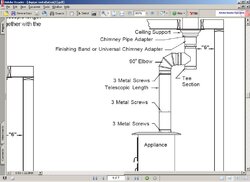I'm doing an install in the new place I'm building, and am looking for any smart ideas I should incorporate in the design to make cleaning the stove pipe/chimney as painless as possible. The class A chimney is installed, I did it a couple years back when I was framing and roofing, it's a straight shot down to the stove, spent a fair amount of time with a plumb bob on the layout. Anyway the stove will be a Hearthstone Mansfield, approximately 14' vaulted ceiling, so about 11 ft of black pipe, then 8ft IIRC of Class A. Most people I know secure their black pipe to the ceiling support box and put the slip joint at the bottom, to clean they slip the joint apart, tape a plastic bag over it and then go up on the roof with the cleaning rods/brush. I'm planning this same approach. Are there any smart tricks I should do, say is there some sort of cleanout that go in the black pipe section that avoids dealing with the expansion joint? In short, for you guys in the know, how would you do such an install if it were in your place?
My old instal was a Quad 5100i insert, cleaning consisted of pulling the air tubes/upper brick and blanket and cleaning the mess into the stove. While not bad, I'd prefer to avoid crawling around quite this much in the firebox this time around.
Thanks.
Bri
My old instal was a Quad 5100i insert, cleaning consisted of pulling the air tubes/upper brick and blanket and cleaning the mess into the stove. While not bad, I'd prefer to avoid crawling around quite this much in the firebox this time around.
Thanks.
Bri


